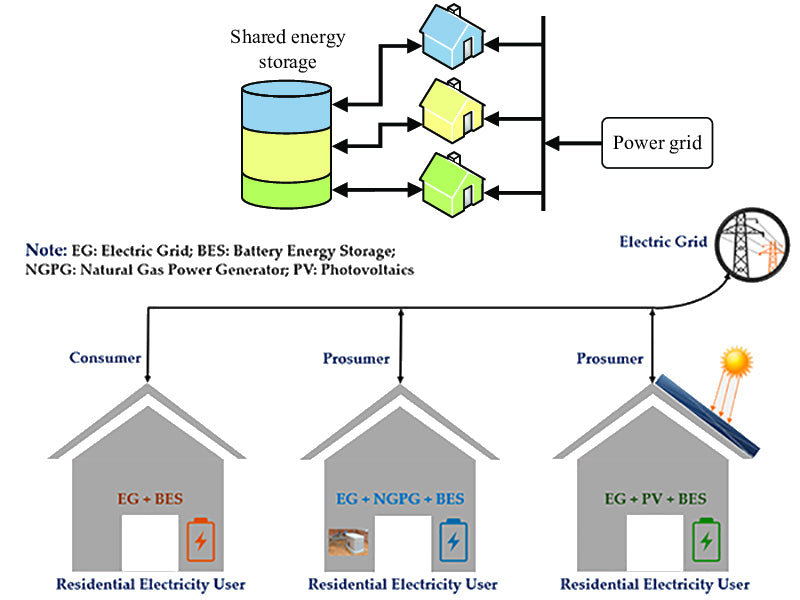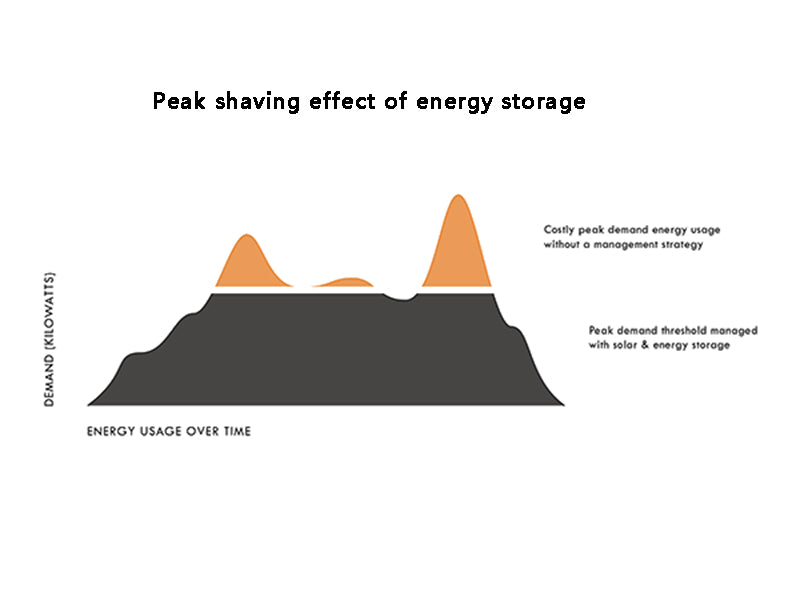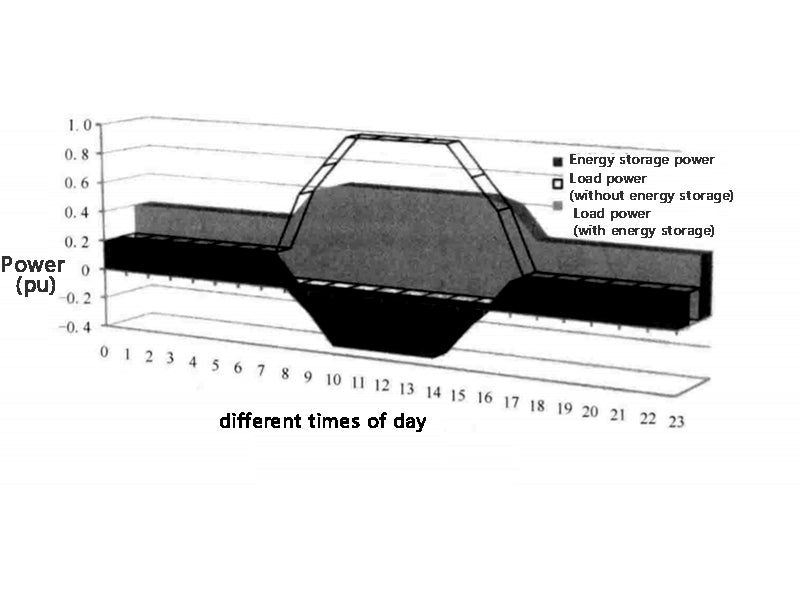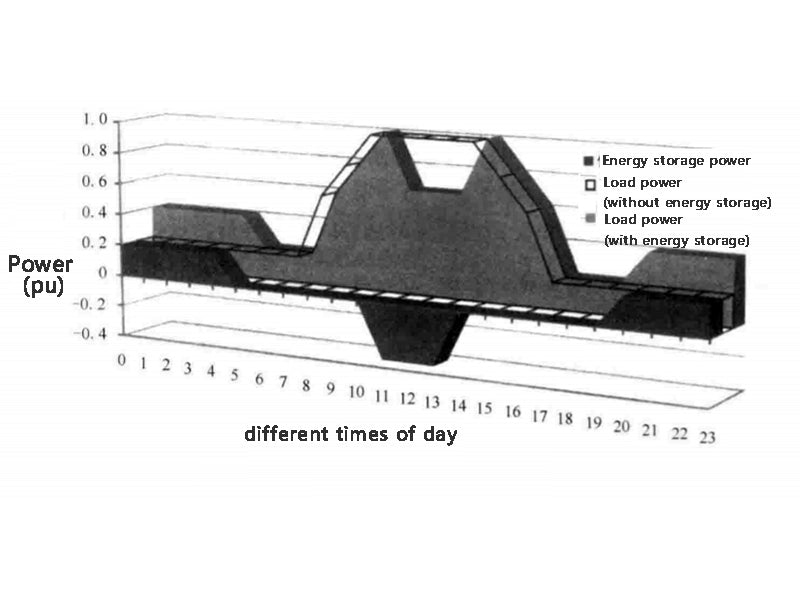
main content:
The following describes the role of energy storage for industrial and commercial users. Despite the complexity of energy storage technology, some of the capabilities that energy storage can bring will be of more or less interest to home users now (or in the near future). For these home users, the space requirement and potential hazards of energy storage systems are the main constraints.

In the role of energy storage on power users, most literatures emphasize the utility of peak shaving. The value of peak shaving comes from the pricing principle of electric energy. The price on the user's electricity bill is generated in part proportional to the requested capacity ("power subscription") and part proportional to the amount of electricity consumed.
However, the power order is only a maximum value that is rarely reached in actual use. From the user's point of view, the power subscription amount is a predetermined amount of electricity consumption. If this amount is exceeded, a large price will be paid for the excess usage.
The main purpose of peak clipping is to reduce the power order by smoothing the user load curve. Energy storage can be charged when demand is low and discharged when demand is high, thereby reducing power subscriptions, a process well illustrated in Figure 1.

Figure 1 Peak shaving effect of energy storage
Obviously, the realization of the above scheme is closely related to the user's load curve and related contracts, including the power subscription cost, the pricing method after the actual subscription amount is exceeded, and so on. The most advantageous situation is to predict short-term load peaks in advance, so that the installed capacity of the energy storage system (and thus the system cost) can be reduced.
An optimized solution is to configure a 130kW/65kW·h lead-acid battery energy storage system, which, after analysis, seems to be profitable (32,000 euros in 20 years, with a payback period of 12 years). But in fact, since the load peak cannot be accurately predicted, the actual energy storage system will be larger in capacity, which will greatly compress the profit margin of the energy storage system. At peak times, its comprehensive benefits will be even less optimistic. In a relatively simple case, it has been confirmed that under certain conditions, industrial users can profitably shave peaks through energy storage.
When evaluating the benefits of load smoothing for energy storage users, other auxiliary functions of energy storage can also be taken into account, such as power quality, power supply continuity or reactive power compensation. In addition, energy storage systems can naturally benefit from delaying electricity consumption if the peak electricity consumption occurs during a time when electricity prices are high.
2. The effect of energy storage on peak shifting power consumption

For consumers, since electricity prices may vary hourly, this difference in electricity prices can be used to decide when to buy what price electricity (including generation and transmission) from the grid. The energy storage device is charged when the electricity price is C1 during the off-peak load period (HC), and discharged when the electricity price is C2 during the peak load period (HP), as shown in Figure 2.

Figure 2 Shifting peak electricity consumption through energy storage
Considering the charge-discharge cycle efficiency η of the energy storage system, in theory, only when the energy storage system is discharged due to the peak load period, so that the cost of avoiding high-priced electricity purchases from the grid is higher than a series of costs such as energy storage charging, the application of energy storage. make sense. this means:
1) The cost of energy storage charging during the off-peak period: ΔCbought=C1Echarged.
2) Reduced electricity purchase cost due to the discharge of energy storage during the peak load period: ΔCrestitution=C2ηEcharged.
3) If ΔCrestitution>ΔCbought (ie C1/C2<η), it is profitable to configure energy storage.
Clearly, in any case, the benefit to consumers of delaying electricity use depends on the provider's pricing scheme. Through the analysis and calculation of the actual data, when the peak-to-valley difference of electricity prices is relatively obvious (the peak electricity price is 0.32 US dollars/kW·h, and the valley electricity price is 0.10 US dollars/kW·h), the energy storage system of each kW installed capacity The annual profit is about 140 US dollars (the discharge time of the energy storage system is 6h, and the charge-discharge cycle efficiency η=0.8).
In France, for energy storage systems that may perform multiple auxiliary functions, the benefits of this delayed use of electricity can at least partially compensate for the losses of the energy storage system itself. In addition, if the peak shaving effect of energy storage is strengthened through contracts with power companies in the future, its foreseeable benefits will be improved.
From an environmental point of view, delaying electricity consumption can transfer the power generation of low-carbon emission power sources during off-peak load periods to peak load periods, thereby reducing the consumption of high-carbon energy sources and contributing to carbon emission reduction.

In the event of occasional power outages in the grid, the energy storage can be used as a backup power supply to continuously supply power to users. It is well known that this function of energy storage can reduce the adverse effects of sudden power outages on some specific users, and has been used commercially for many years. For some loads, no matter how long the power outage lasts, once the power outage is lost, the loss has already occurred (for example, some electronic equipment may suffer data loss). In this case, one power cycle (one cycle of a sine wave) can be instantaneously provided by a power supply with a fast response capability. Of course, this short-term power supply support may also need to last for more than one sine cycle, and even active power off can only be done when some devices complete the backup task. In other cases, the duration of the power outage has a great influence on it (such as cold storage), and it is very necessary to use a backup power supply at this time. There is no limit to the start-up response time of this backup power supply, but it must be ensured that it can operate automatically.
In addition, installing an energy storage system on the user side can filter disturbances from the power grid, so that a special power quality control device can be used to improve the power supply quality of important loads. For example, in power supply systems for sensitive loads, energy storage can be used to eliminate power quality problems such as voltage sags.
Uninterruptible Power Supply (UPS) is a commercial product that covers almost all possible energy storage technologies. The application of UPS is very extensive, its power can be as high as 20MV·A, and the continuous power supply time varies from several seconds to several hours (standby diesel generator sets can be used for long-term power supply). Some prototypes of active filters also exist on the market, but are still in their infancy.
The extent to which users are willing to invest in improving power quality and supply reliability is closely related to the losses suffered due to poor power quality or power outages. The amount of investment in the energy storage system is related to its operation process and energy storage materials. From the perspective of return on investment accounting, it will be more difficult to convince residential users to invest in energy storage systems because it is difficult to change their personal electricity consumption habits.
There are many examples of using energy storage to ensure power quality and power supply continuity. Such as the 15MV·A uninterruptible power supply system of a semiconductor factory of ST Microelectronics (initially 12.5MV·A). In the four years since it was built in August 2000, the system has successfully eliminated more than 100 incidents of power disturbances, including outages lasting 20 seconds. For the company, the economic benefits of an energy storage system of this size (connected directly to the plant's MV-class substation) outweigh the economic benefits of adopting a fleet of small, low-voltage energy storage systems.
Some energy storage's very high charge and discharge cycles are also important support points for energy storage applications. Two sodium-sulfur (NAS) battery modules (one for 50kW/7.2h, another 250kW/30s for instantaneous pulse discharge), several energy storage functions (mainly including smoothing peak load and delayed power consumption, etc.) that will be very useful to users are integrated together, and ensure Instantaneous power supply protection for loads to deal with voltage drops, short-term power outages and long-term power outages. The results obtained from the study were positive, and over a period of more than four and a half months (from February to mid-June 2002), all power supply problems could be solved by installing an energy storage system.

In France, from November of each year to March of the following year, medium-voltage power users or low-voltage users with power consumption greater than 36kV·A need to pay for reactive power consumption exceeding tan ψ = 0.4, and the reactive power price is 1.77 EUR/kV.Arh and 1.86 EUR/kV.Arh.
Distributed energy storage can make up for the reactive power consumed by local loads through the control of its power electronic grid-connected access device. Power system operators that deploy energy storage can benefit from this feature of energy storage. This economic benefit is compared to the reactive power bill, or to the cost of installing a reactive power compensation capacitor bank, which allows the power user to achieve the power contracted with the distribution system operator (DSO). factor.















